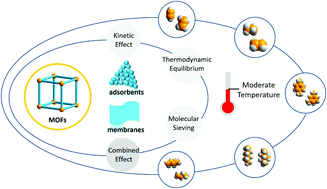Energy-efficient separation alternatives: metal–organic frameworks and membranes for hydrocarbon separation
Abstract
Hydrocarbon separation is one of the most critically important and complex industrial separation processes, offering versatile bulk chemicals and vital support to the national economy. Traditional separation technologies, such as cryogenic distillation and solvent extraction, are energy-intensive and cause serious environmental stress. Moreover, the growth of industries and technologies and the greater requirements for products (e.g., purity) lead to challenges that cannot be met using traditional separation methods. Adsorptive and membrane-based separations are recognized as energy-efficient alternatives by which to revolutionize the current energy-intensive conditions and satisfy the new demands. This critical review presents the recent progress in metal–organic frameworks (MOFs) and related membranes (e.g., continuous MOF membranes and mixed-matrix membranes) for hydrocarbon separation. The contributions of the underlying separation mechanisms (e.g., enthalpy-driven thermodynamic equilibrium, molecular sieving, kinetic separation based on molecular size, and combined mechanisms) and the adopted strategies (e.g., defect and microstructure control, membrane thickness and interfacial compatibility) to the breaking of trade-off (e.g., permeability/selectivity and capacity/selectivity) and the design of novel materials and processing technologies are discussed. Moreover, this review also summarizes the potential barriers that exist from the academic to the ultimate industrial implementations and the prospects of future development.



 Please wait while we load your content...
Please wait while we load your content...